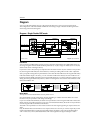
Overview
1
Overview
The
TRINITY series
has two types of effects:
Insert Effects
and
Master Effects
.
As shown in the figure below, you can use the Insert Effects in the process of sound creation after the
Oscillator, Filter, and Amp. Then, reverberation and other effects are applied through the Master Effects.
One hundred
Insert Effects and
fourteen
Master Effects enable highly flexible sound production.
The
TRINITY series
does not have an input level meter to recognize the effect input level. Please
note that if the input level is not high enough, the S/N ratio may be reduced, and if the input level
is excessive, clipping may occur.
To obtain the optimum degree of effects, first set the input level of the Insert Effect and Master
Effect to the maximum possible without clipping, then adjust the effect output level using the Wet/
Dry parameter of the Insert Effects, and the Output Level parameter and/or Return 1 and 2 of the
Master Effects.
The following table shows the parameters that can be used to adjust the input/output levels:
* Certain effects may not utilize some of these parameters.
Insert Effects
Insert Effects are used as part of the sound creation process.
You can select any effects from the effect library, which contains
100 effects
, ranging from effects that
change tone and dynamics, such as the equalizer, limiter, exciter, etc.; to effects that simulate particular
characteristics of certain musical instruments, such as amp simulation, rotary speaker, and piano body/
damper simulation; effects that create conventional effect sounds, such as ring modulator, talking modu-
lator, vocoder, and pitch shifter; completely new types of effects, such as decimator and resonator; and
classic effects, such as reverberation, chorus, delay, and overdrive.
Insert Effects employ the concept of “
size
”, which allows for more flexible effect routing appropriate for
your own application.
In Program mode, you can use up to
three effects in series
(or up to
four effects in series/parallel
for a
Drum mode Program).
In the Combination and Sequencer modes, you can use up to
three effects
in series for each Timbre or
Track (or up to
four effects in series/parallel
for each Timbre or Track that uses a Drum mode Program).
In total, you can use up to
eight effects
for all Timbres/Tracks.
For more detailed information, refer to the block diagrams and explanations below for each mode.
Program Edit mode Combination Edit mode Sequencer mode
Input
OSC1/2 High, Low Level (P1)
Filter1/2 A/B Gain (P3)
Amp1/2 Level (P5)
Send1/2 (P5 or P7)
Trim Parameter (P7, P8)*
Volume (P1)
Send1/2 (P1)
Trim Parameter (P7, P8)*
Volume (P1)
Send1/2 (P1)
Output
Wet/Dry (P7)
Output Level (P8)
Retrurn1, 2 (P8)
Wet/Dry (P7)
OutPut Level (P8)
Return1, 2 (P8)
Output Level (P8)
Return1, 2 (P8)
Insert Effect
Master Effect
EQ
Send Return
Oscillator
Filter
Amp
+


















